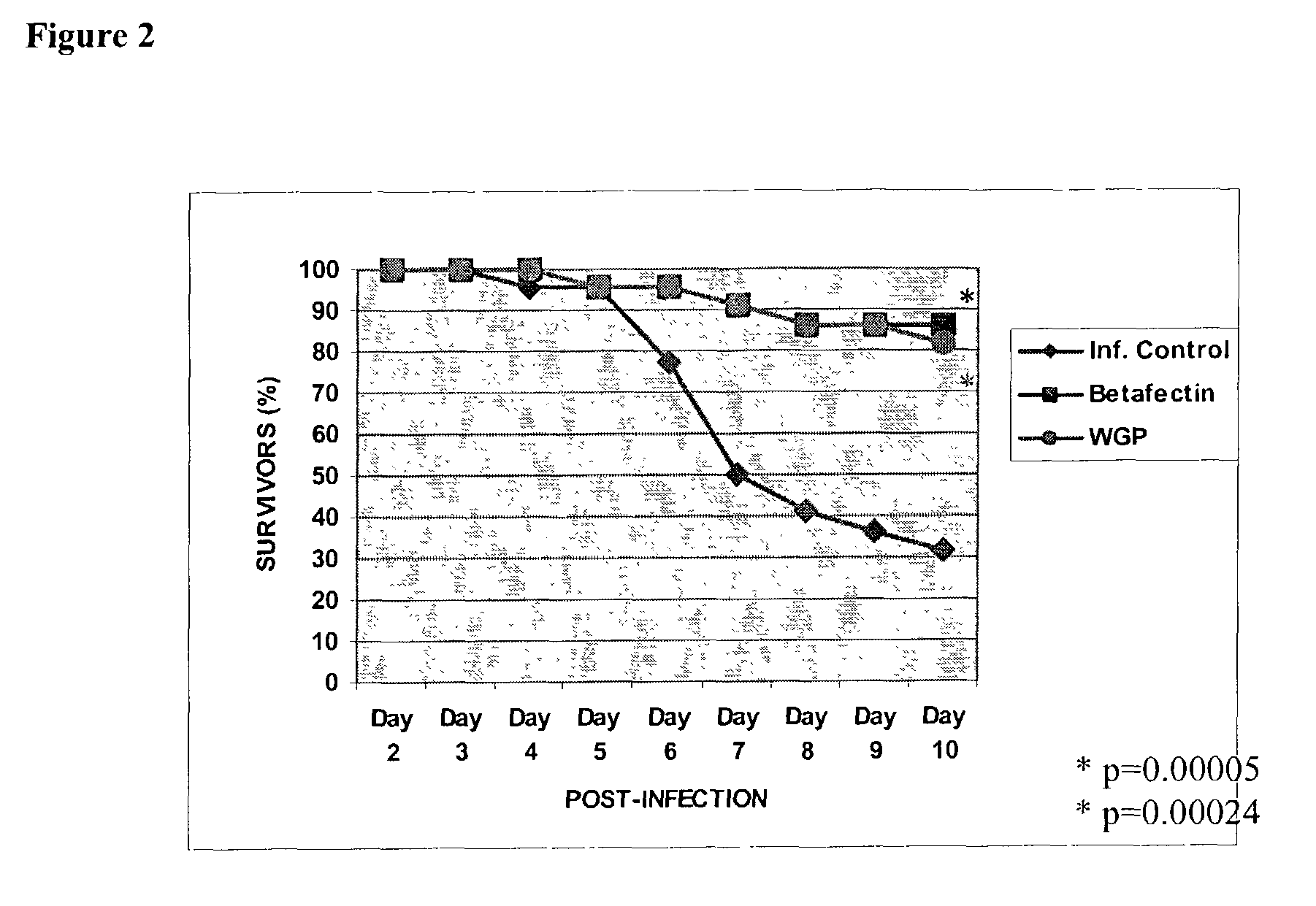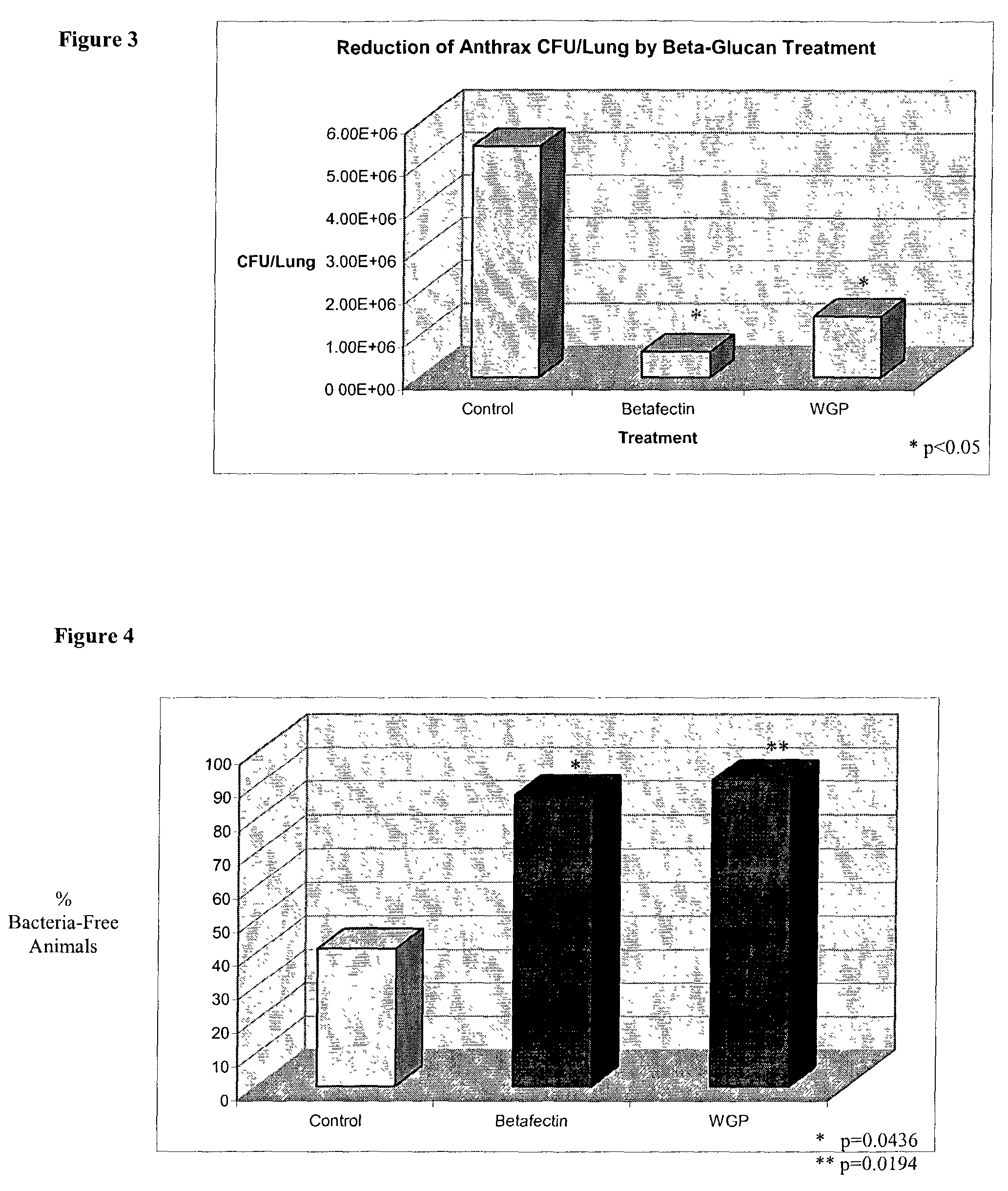Use of beta-glucans against biological warfare weapons and pathogens including anthrax
a technology of beta-glucans and biological warfare weapons, applied in the field of biological warfare weapons paralysis or treatment of infection by pathogenic organisms such as anthrax, can solve problems such as public panic and social disruption, cutaneous anthrax, gastrointestinal anthrax,
- Summary
- Abstract
- Description
- Claims
- Application Information
AI Technical Summary
Benefits of technology
Problems solved by technology
Method used
Image
Examples
example 1
Beta-Glucan Stimulation of NK Cell Cytokine Release
[0091]Human NK cells were cultured with either particulate yeast β-glucan or soluble CR3-binding polysaccharides for 18 hours at 37° C. Culture supernatants were then analyzed for TNF-α by ELISA. Particulate yeast β-glucan (2 μg / ml) and grifolan (≧500 kDa soluble β-glucan from Grifola frondosa, 2 μg / ml) are able to bind and crosslink the lectin sites of surface CR3 molecules, causing cellular activation and the secretion of both TNF-α and IL-6 (not shown). By contrast, the small (20 kDa) soluble yeast β-glucan (MP β-glucan; 2.0 μg / ml) and SZP (soluble zymosan polysaccharide preparation containing β-oligomannan and / or β-glucan; 2.0 μg / ml) bind only to individual CR3 molecules and do not trigger cytokine release in the absence of target cells. Binding of small β-glucans to CR3 resulted in receptor priming for subsequent cytokine release triggered by ligation to an iC3b-opsonized target cell (sheep erythrocytes opsonized with iC3b-“+EC...
example 2
Beta-Glucan Treatment of Infection
[0092]A sepsis model was developed in mice to characterize the efficacy of PGG glucan in protecting an immunologically intact host against serious infections. The model used intraperitoneal challenge of mice with an 0.1 ml suspension of E. coli strain TVDL-rat (approximately 10 CFU / ml) 24 hours following intravenous administration of PGG by a single bolus injection using transthoracic cardiac puncture. Mice were returned to their cages and maintained on food and water, ad libitum. A control group of 10 mice were injected with 0.1 ml sterile saline at the time of the PGG administration. Mortality rates for the treatment groups and saline control group were recorded at 48 hours after challenge. The survival rate of mice given saline was 20%. However, the survival rates of mice given PGG at doses of 0.01, 0.1, 1, and 5 mg / mouse were 90%, 75%, 70% and 70% respectively. The results demonstrated that PGG significantly reduced mortality, as compared to the...
example 3
Anthrax Animal Model
[0093]Bacillus anthracis Vollum 1B, a virulent, encapsulated, toxin-producing strain (obtained from USAMRIID, Ft. Detrick, Md., USA) was propagated on blood agar plates and suspended in phosphate buffered saline (PBS), and animals challenged in a level 3-biocontainment facilities at DRES, Canada. The cell suspension was heat shocked at 80° C. for 11 min in PBS to kill vegetative cells and aliquots stored at −80° C. The frozen spore stock was diluted and used in the protection studies. Animals were maintained at a maximum of 5 mice / cage under standard laboratory condition, and water and chow were given ad libitum. Injections were performed inside Biosafety Fumehoods, on secured animals.
[0094]The anthrax model used was a well-known mouse (Balb / c) model previously described by Welkos et al. (Infect. Immun. 51:795-800, 1986). Female Balb / c mice (6 weeks old, 14 to 16 g) were purchased from Charles River. Handling of animals was performed inside BL-3 Fume hoods, on se...
PUM
| Property | Measurement | Unit |
|---|---|---|
| size | aaaaa | aaaaa |
| temperatures | aaaaa | aaaaa |
| temperatures | aaaaa | aaaaa |
Abstract
Description
Claims
Application Information
 Login to View More
Login to View More - R&D
- Intellectual Property
- Life Sciences
- Materials
- Tech Scout
- Unparalleled Data Quality
- Higher Quality Content
- 60% Fewer Hallucinations
Browse by: Latest US Patents, China's latest patents, Technical Efficacy Thesaurus, Application Domain, Technology Topic, Popular Technical Reports.
© 2025 PatSnap. All rights reserved.Legal|Privacy policy|Modern Slavery Act Transparency Statement|Sitemap|About US| Contact US: help@patsnap.com



